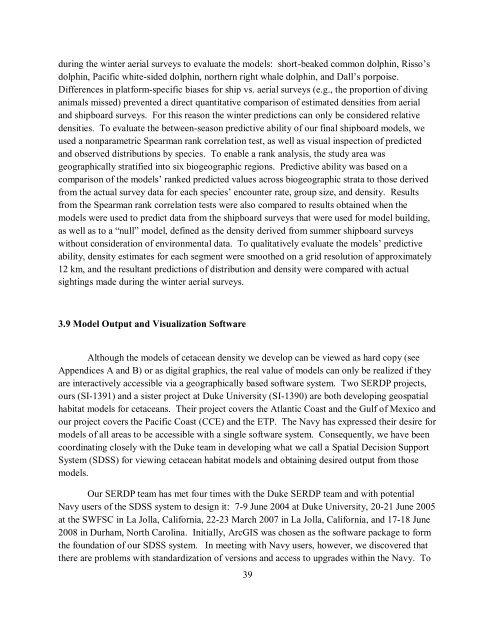Final Technical Report: - Southwest Fisheries Science Center - NOAA
Final Technical Report: - Southwest Fisheries Science Center - NOAA
Final Technical Report: - Southwest Fisheries Science Center - NOAA
You also want an ePaper? Increase the reach of your titles
YUMPU automatically turns print PDFs into web optimized ePapers that Google loves.
during the winter aerial surveys to evaluate the models: short-beaked common dolphin, Risso’s<br />
dolphin, Pacific white-sided dolphin, northern right whale dolphin, and Dall’s porpoise.<br />
Differences in platform-specific biases for ship vs. aerial surveys (e.g., the proportion of diving<br />
animals missed) prevented a direct quantitative comparison of estimated densities from aerial<br />
and shipboard surveys. For this reason the winter predictions can only be considered relative<br />
densities. To evaluate the between-season predictive ability of our final shipboard models, we<br />
used a nonparametric Spearman rank correlation test, as well as visual inspection of predicted<br />
and observed distributions by species. To enable a rank analysis, the study area was<br />
geographically stratified into six biogeographic regions. Predictive ability was based on a<br />
comparison of the models’ ranked predicted values across biogeographic strata to those derived<br />
from the actual survey data for each species’ encounter rate, group size, and density. Results<br />
from the Spearman rank correlation tests were also compared to results obtained when the<br />
models were used to predict data from the shipboard surveys that were used for model building,<br />
as well as to a “null” model, defined as the density derived from summer shipboard surveys<br />
without consideration of environmental data. To qualitatively evaluate the models’ predictive<br />
ability, density estimates for each segment were smoothed on a grid resolution of approximately<br />
12 km, and the resultant predictions of distribution and density were compared with actual<br />
sightings made during the winter aerial surveys.<br />
3.9 Model Output and Visualization Software<br />
Although the models of cetacean density we develop can be viewed as hard copy (see<br />
Appendices A and B) or as digital graphics, the real value of models can only be realized if they<br />
are interactively accessible via a geographically based software system. Two SERDP projects,<br />
ours (SI-1391) and a sister project at Duke University (SI-1390) are both developing geospatial<br />
habitat models for cetaceans. Their project covers the Atlantic Coast and the Gulf of Mexico and<br />
our project covers the Pacific Coast (CCE) and the ETP. The Navy has expressed their desire for<br />
models of all areas to be accessible with a single software system. Consequently, we have been<br />
coordinating closely with the Duke team in developing what we call a Spatial Decision Support<br />
System (SDSS) for viewing cetacean habitat models and obtaining desired output from those<br />
models.<br />
Our SERDP team has met four times with the Duke SERDP team and with potential<br />
Navy users of the SDSS system to design it: 7-9 June 2004 at Duke University, 20-21 June 2005<br />
at the SWFSC in La Jolla, California, 22-23 March 2007 in La Jolla, California, and 17-18 June<br />
2008 in Durham, North Carolina. Initially, ArcGIS was chosen as the software package to form<br />
the foundation of our SDSS system. In meeting with Navy users, however, we discovered that<br />
there are problems with standardization of versions and access to upgrades within the Navy. To<br />
39









